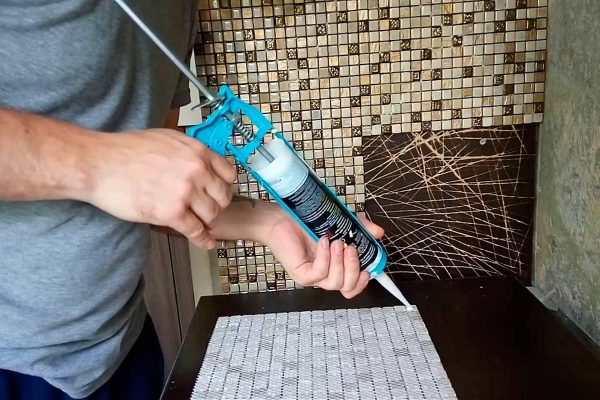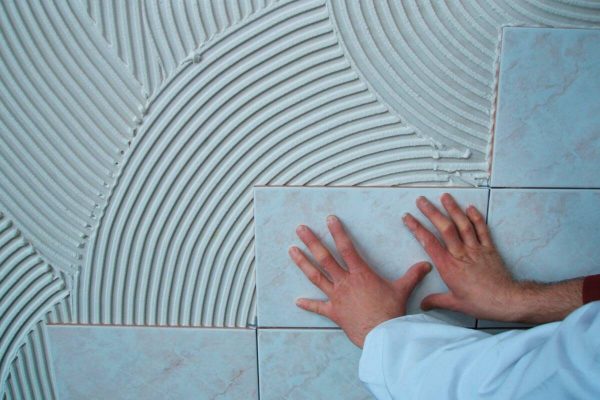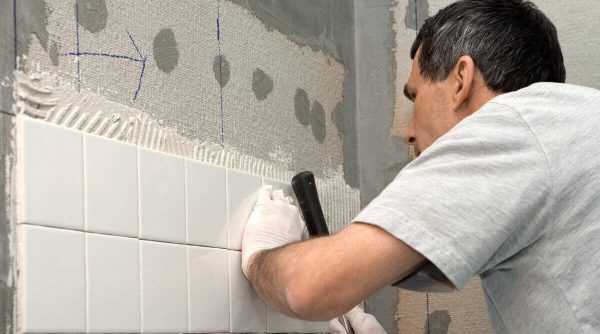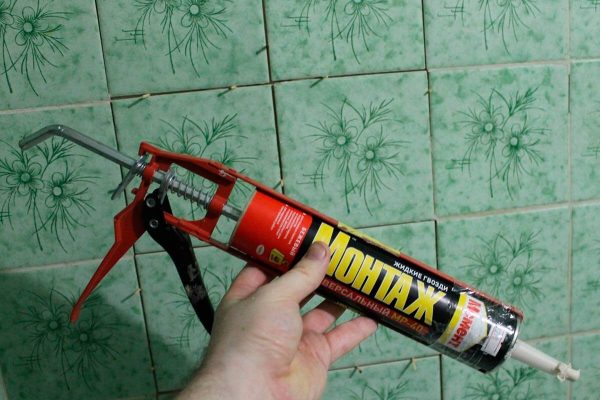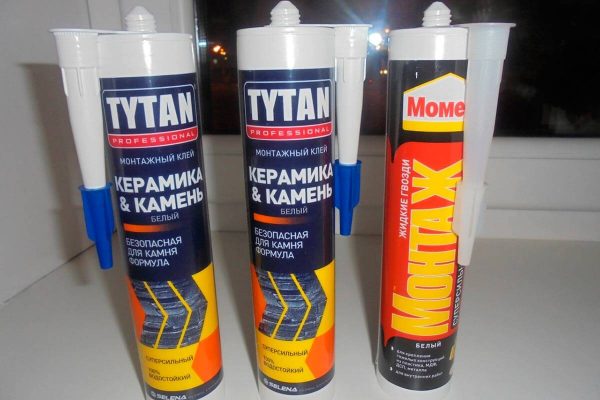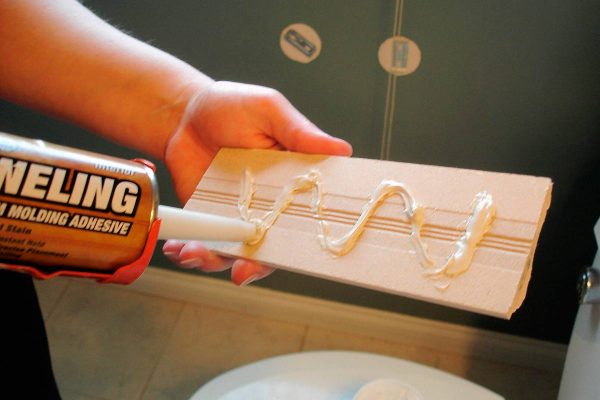Tile laying in the bathroom is most often done on cement or special building mixtures. But in some cases, liquid nails are used for ceramic tiles - a special adhesive composition that has high adhesion, reliability and durability.
- What are liquid nails
- Types of glue
- Pros and cons
- Is it possible to stick tiles on liquid nails
- Glue selection
- How to glue the tiles on the wall on liquid nails
- Surface preparation for work
- Gluing tiles
- Use of glue in work with various tile materials
- Liquid Nail Consumption
- Ceramic Decay
- How to remove liquid nails
- Service life: how to extend
- Partial repair liquid nails
- Manufacturers and cost

What are liquid nails
When choosing tile glue, masters often prefer liquid nails, because when using cement you can not avoid a lot of dust, and it will take a long time to wash the bathroom. Work with cement is quite laborious: the solution must be kneaded in small portions, which is difficult to do manually, and it is unrealistic to bring a concrete mixer into the house. Liquid nails in such a situation will be an excellent solution - with their help, the process of sticker tiles is greatly simplified.
Liquid nails mean a polymer-based adhesive solution with the addition of chalk, white clay, and other fillers to help level the porous surface of the base. A dense, thick adhesive mass is placed in special tubes that are convenient to use and designed for refueling in a gun.
Liquid nails are considered a universal tool - they allow you to glue various materials, including ceramics, glass, natural and artificial stone. After solidification, the composition is very durable and does not lose its properties for a long time. Nails are available in a variety of colors, but most often on sale you can find such shades:
- white;
- Gray;
- brown;
- transparent and translucent (whitish);
- yellow;
- the black.
For work with ceramics, white liquid nails are usually used, and transparent compositions, due to their reduced strength, are mainly used as a sealant for plumbing.
to contents ↑Types of glue
Liquid nails are sold in two varieties, depending on the composition and properties:
- Acrylic The base is acrylic in the form of an aqueous emulsion. They are non-toxic, completely safe for humans, can be used even indoors, since they are odorless.
- Neoprene. It is based on polymer components and organic solvents that are harmful to health. When using, do not forget about personal protective equipment and thoroughly ventilating the room.
The degree of adhesion of neoprene adhesives is much higher than that of acrylic. Liquid nails on solvents quickly set on the bases, durable, able to glue even smooth, glossy materials. Neoprene adhesives are more suitable for working with tiles in the bathroom, since they are the most resistant to moisture and do not deteriorate from temperature extremes.
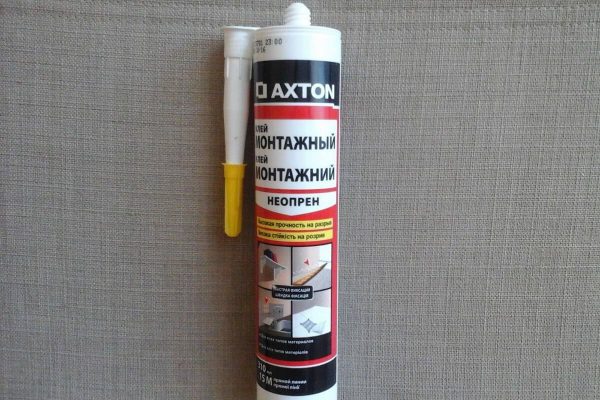
Pros and cons
Liquid nails are becoming more and more popular during repairs in the bathroom and in the kitchen.They are great for gluing ceramic tiles, because they have several advantages:
- water resistance - polymers in the composition are not afraid of moisture, can withstand even direct contact with water, do not deteriorate when liquid enters the tile seam;
- strength - as it dries, a solid layer of glue is formed, which tightly connects the tile to the base;
- preservation of properties - unlike cement and gypsum mixtures, liquid nails maintain their original qualities throughout the entire period of operation;
- high adhesion - some grades of adhesives easily withstand weight up to 80 kg / sq. m and even more, so they are able to hold on the wall a large tile, granite;
- resistance to negative factors - adhesives are not afraid of mold, do not rot, do not collapse, and are completely not subject to corrosion compared to metal nails;
- ease of operation - a special gun is used to extrude liquid nails, which greatly facilitates the process and makes application very accurate (the laying speed also increases);
- convenience - liquid nails are sold in finished form, they do not need to be kneaded, bred, removed from the tank, which reduces the time and effort, eliminates the need to measure the proportions;
- cleanliness - in the room where work with liquid nails is carried out, it will always be clean and dry, in contrast to the place where cement or gypsum mixtures are used.
Disadvantages of liquid nails are few, but they are. Most compositions have a relatively short time to adjust, so it’s better to immediately lay the tiles straight or try to quickly align its position. Already after 5-10 minutes, the glue will set, and tidying up large masonry will not work without proper experience.
to contents ↑Liquid nails are an order of magnitude more expensive than cement mixtures. If you want to make repairs in the entire bathroom, the costs will be serious. Glues of this type are sold in closed cartridges of 300-500 ml, no more, so you will have to overpay for the packaging.
Is it possible to stick tiles on liquid nails
The scope of application of liquid nails is extensive, because they are considered a universal remedy. Glues are suitable for porous and smooth materials, although specialized formulations are often produced for tiles. Ceramics adhere perfectly to nails, not only for wall decoration, but also for flooring. Fine-grained fillers guarantee bonding even of loose parts of large and light weight.
Most often, liquid nails are used for partial repairs, because it is too expensive to completely cover the bathroom with them. It is undesirable to use glue in places that will be under water, for this purpose it is better to use special cement compounds with enhanced water resistance. Another option is to use liquid nails, but smear the seams with a special water-repellent grout.
to contents ↑
Glue selection
When facing the bathroom, you should choose an adhesive that can easily withstand high humidity. It is also important to consider the size of the tile to be attached: for porcelain stoneware and large elements, it is worth buying liquid nails with enhanced adhesion. If you have to stick elements on concrete or brick, it is better to purchase liquid neoprene-type nails; for drywall, you can use acrylic compounds.
Also, when buying, you need to pay attention to such indicators:
- drying speed;
- suitability for indoor or outdoor use;
- temperature condition;
- fire safety;
- smell.
How to glue the tiles on the wall on liquid nails
Facing walls or floors with tiles can be done in different ways:
- applying adhesive to the wall;
- glueing tiles;
- simultaneous processing of tile and glue with liquid nails.
Typically, the latter option is used with a large tile size or its significant weight. Before work, an approximate scheme is determined by arranging the rows so that the minimum number of elements has to be cut.
to contents ↑Surface preparation for work
First, prepare the base - clean it from grease, dust, dirt. Any previous materials and their residues are also removed, and irregularities are covered with cement mixtures (screed is poured on the floor, otherwise the ceramic will lie crookedly). After the base is primed 1-2 times to improve adhesion to the tile, and wait for complete drying.
to contents ↑Gluing tiles
If the glue is toxic, install the tiles only with a respirator and gloves. A cylinder with liquid nails is placed in a gun, cut off the tip, make a test extrusion of the composition. Then they act like this:
- apply glue to a tile or wall pointwise, zigzag or mesh;
- wait 20-30 seconds;
- lean the element against the wall, starting from the bottom;
- hold for several minutes (according to instructions);
- large tiles are gently tapped with a rubber mallet to evenly fix it;
- after the installation is completed, the adhesive is allowed to dry completely and gain the proper strength (about a week), and only then they begin to grout the joints.
To the distance between the elements was the same, use dividing crosses. You can remove them after 3 hours after the end of all work.
to contents ↑
Use of glue in work with various tile materials
Liquid nails are suitable for laying tiles of different textures, shapes, types. If the ceramic elements are small or medium in size, a point application of glue around the perimeter is sufficient. Large elements can be processed with a snake, leveling the applied composition with a spatula. Using liquid nails, you can fix the mirror tiles, gypsum parts, stone or mosaic tapes on the walls, ceiling. The heavier the material, the more thorough the application should be.
to contents ↑Liquid Nail Consumption
Consumption greatly depends on the specific type of product, as well as other factors:
- degree of flatness of the surface;
- features and weight of the tile, the amount of glue applied;
- master’s experience, laying speed.
If glue is squeezed out of a standard tube of liquid nails, the strip will be 30–35 meters long with a nozzle thickness of about 2 mm, although such a seam width is not enough to hold the tile. The optimum thickness of the adhesive strip is 5–6 mm, for which you need to correctly cut the nozzle of the cartridge. Usually in this case, one package is enough for 10-15 linear meters of tiles of any size.
to contents ↑Ceramic Decay
It happens that individual elements fall off the wall after work. From this place you need to immediately remove the remnants of glue, the elements themselves also clean. Care should be taken, because the material is quite fragile, and neighboring tiles can be damaged. Apply new glue to the cleaned areas, fix the element with your hands on the wall. Seams can be wiped only after the glue has completely dried (at least 7 days).
to contents ↑How to remove liquid nails
This type of glue sticks tight to the surface, and getting rid of it is quite difficult. There are several methods for removing material:
- Solvents and cleaners. These funds are sold in hardware stores. They moisten the base, after 15 minutes, wipe together with the dissolved composition.
- Scraper. Using a sharp metal or plastic scraper, dried glue can be removed mechanically. Instead of a scraper, a metal spatula is suitable.
- Screwdriver. By attaching a brush head to the device, you can quickly and easily clean the glue from the tile or wall.
- Burner.The glue stains are slightly heated with a small burner to about +60 degrees, and then easily removed with a spatula and a rag. Instead of a burner, professionals often use a building hair dryer.
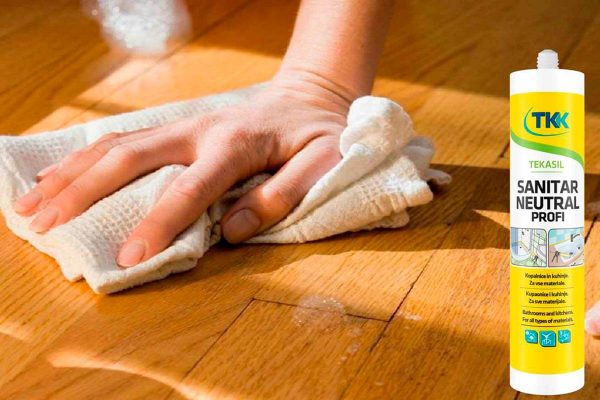
Service life: how to extend
Liquid nails are considered quite durable material, they can last for several years from the date of application. To increase the service life, you should use these tips:
- to correct the thickness, size, other parameters of the seam immediately after completion, when the glue has not yet seized;
- work at room temperature, since when it decreases to +10 degrees or less, the properties of the composition may deteriorate;
- work only with glue with a normal shelf life, stored under suitable conditions, not dried out.
Partial repair liquid nails
If in the bathroom you need to replace part of the peeled off or deteriorated tiles, there is no better option than to put them on liquid nails. First, the base is cleaned of old glue, degreased, remove all impurities. Mold is destroyed, and the wall is treated with an antifungal composition. The crumbling plaster is uncovered, the site is leveled with cement mortar.
to contents ↑Elimination of irregularities is an important stage of work, because when it is ignored, the tile will protrude forward or sink in comparison with the rest of the surface. The glue is applied to the elements in a standard way, press them against the wall, hold for a couple of minutes and allow to dry completely.
Manufacturers and cost
The price of packing liquid nails can vary greatly depending on the brand, country of production. Typically, the cost of funds varies between 80-450 rubles, although there are more expensive compounds.
The most popular adhesives on the market are:
- Titebond Multi Purpose. It unites any materials dead, the hardening time is increased (20-30 minutes), which allows even a novice to work with glue. Frost and moisture resistant composition, almost odorless.
- "The moment of installation is universal." Synthetic resin based agent is excellent for brick, metal, concrete, ceramics. It has great joint strength, does not deteriorate when heated to +70 degrees and cooled to –40 degrees.
- LIQUID NAILS LN-901. Special liquid nails for stone and neoprene type tiles based on artificial rubber. Can be used for outdoor applications, durable and resistant to shock loads.
- Tytan Pottery and Stone. Flavourless acrylic glue, does not contain solvents, is environmentally friendly. Grasps very quickly, reliable, can be painted after drying.
The main advantage of liquid nails is their strength, therefore adhesives are suitable for almost any tile raw material. They do not require special care, while the operation will be long and trouble-free.

